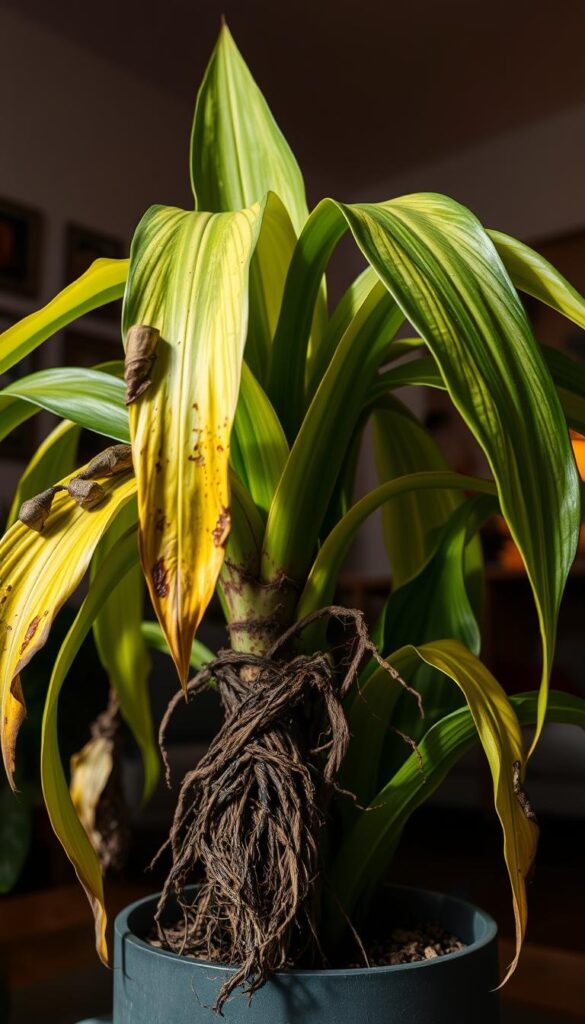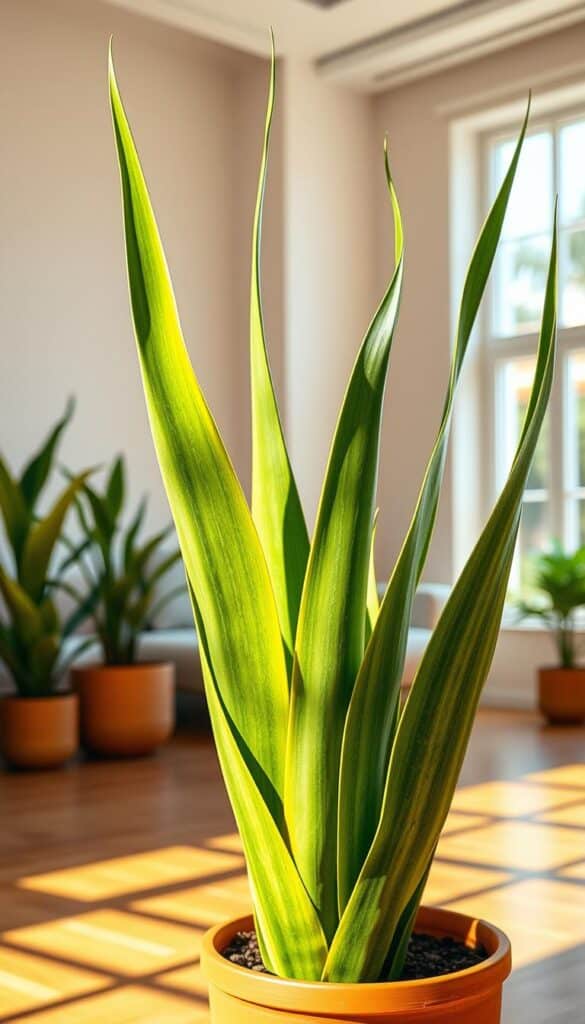Have you noticed your snake plant’s leaves drooping lately? You’re not alone. Even though these plants are known for their hardiness, they can still show signs of distress. I’ve seen my own snake plant’s leaves droop, and it’s worrying. But there’s good news—reviving your plant is possible with the right care.
Overwatering is a common culprit. Too much water can lead to root rot, causing the leaves to droop. Experts like Petar Ivanov and Paris Lalicata from Fantastic Gardeners, and Matt Slaymaker from The Sill, agree that understanding watering, light, and soil conditions is key to your plant’s health.
Recognizing signs early is crucial. Yellowing or mushy leaves can indicate root rot. By addressing these issues step-by-step, you can nurse your plant back to health. Proper care can restore your snake plant’s vibrant appearance, bringing it back to its lively self.
- Snake plants can droop due to overwatering or root rot.
- Monitor watering, light exposure, and soil conditions.
- Early signs of trouble include yellowing or mushy leaves.
- Proper care can revive a drooping snake plant.
Understanding Your Snake Plant’s Needs
Snake plants are known for their resilience, but they still require proper care to thrive. As a houseplant owner, it’s essential to understand what your plant needs to stay healthy. I’ve learned that distinguishing between normal aging and stress symptoms is crucial for maintaining your plant’s well-being.
Recognizing Normal Aging vs. Stress Symptoms
Snake plants naturally shed their older leaves as new ones grow. This process is a normal part of their life cycle. However, if your plant’s leaves are drooping or losing their vibrant color, it could signal stress rather than just aging. Yellowing or soft leaves are often signs of overwatering, while dry, brittle leaves might indicate underwatering.
The Roles of Water, Light, and Soil in Plant Health
Water, light, and soil are the foundation of a snake plant’s health. Overwatering can lead to root rot, causing leaves to droop. On the other hand, too little water can also make leaves flop over. These plants prefer well-draining soil and moderate indirect light. They can tolerate low light conditions but will grow more robustly in bright, indirect light.
https://www.youtube.com/watch?v=FnShxIKP98c
Seasonal changes, like winter, affect watering needs. During colder months, your plant requires less water. Paying attention to these factors ensures your snake plant remains healthy and thrives in its environment.
Common Issues Affecting Your Snake Plant’s Health
Snake plants, despite their hardiness, can face several health issues that cause their leaves to droop. These problems often stem from environmental factors and improper care. Recognizing these issues early can help prevent further damage and restore your plant’s health.
Overwatering and Root Rot Challenges
Overwatering is the most common culprit behind a drooping snake plant. When the soil remains soggy for too long, it can lead to root rot. This condition causes the roots to decay, turning them mushy and discolored. As a result, the plant’s leaves may yellow and droop, struggling to absorb the necessary nutrients and water.
Poor drainage and soil quality can exacerbate these issues. If your pot doesn’t have proper drainage holes, water can pool at the bottom, creating an ideal environment for root rot. Experts recommend using well-draining soil and a container with adequate drainage holes to prevent such problems.
Pest Infestations and Repotting Concerns
Pests like mealybugs and spider mites can also weaken your snake plant. These tiny insects feed on the plant’s sap, causing the leaves to droop and lose their vibrancy. Mealybugs often appear as small, cotton-like clusters, while spider mites create fine webbing on the leaves. Regularly inspecting your plant and treating infestations early can prevent severe damage.
Another common issue is a root-bound condition, where the plant has outgrown its container. If the roots become too crowded, the plant may struggle to absorb water and nutrients, leading to droopy leaves. Repotting your snake plant into a slightly larger container with fresh soil can alleviate this problem and promote healthy growth.

- Overwatering leads to root rot, causing yellowing and mushy leaves.
- Poor drainage and soil quality worsen root rot issues.
- Pests like mealybugs and spider mites weaken the plant, causing droopy leaves.
- Root-bound conditions require repotting to ensure healthy growth.
- Using well-draining soil and pots prevents common problems.
By addressing these issues promptly, you can restore your snake plant’s health and prevent future problems. Regular monitoring and proper care will help your plant thrive and maintain its vibrant appearance.
Step-by-Step Diagnosis: why is my snake plant drooping
Is your snake plant showing signs of distress? Diagnosing the issue early can make all the difference. Let’s break down a simple, step-by-step process to identify the cause of your snake plant’s droopy leaves.
Evaluating Your Watering Practices
Start by examining your watering habits. Overwatering is a common issue that leads to root rot, causing leaves to droop. To avoid this, ensure the soil dries completely between waterings. I use a simple finger test: stick your finger into the soil up to the first knuckle. If the soil feels dry, it’s time to water.
Inspecting Soil Drainage and Light Exposure
Next, check the soil drainage and light conditions. Proper drainage is crucial to prevent waterlogged soil. Look for drainage holes in your container and ensure the soil isn’t retaining too much water. Light exposure is another key factor—snake plants prefer bright, indirect light but can tolerate low light. However, too little light may cause weak growth and droopy leaves.
| Factor | What to Check |
|---|---|
| Watering | Soil dryness between waterings |
| Drainage | Drainage holes in the pot |
| Light | Exposure to indirect light |
| Roots | Signs of rot or mushy texture |
By following these steps, you can pinpoint the cause of your snake plant’s drooping leaves and take the right corrective actions.
Revive Your Snake Plant: Essential Care and Maintenance
Reviving a drooping snake plant requires careful attention to its environment and care routine. With the right approach, you can restore your plant’s health and vitality. Let’s explore the essential steps to help your plant recover and thrive.
Optimizing Watering and Soil Conditions
Watering is a critical factor in your snake plant’s health. Use just enough water for your succulent, ensuring the soil isn’t soggy. Replace old, poorly draining soil with a mix designed for succulents to prevent root rot. Proper drainage is key to avoiding waterlogged soil and root issues.
Adjusting Light, Temperature, and Preventing Pests
Move your plant to a brighter spot if needed, avoiding direct sunlight. Maintain a consistent indoor temperature between 65-75°F for optimal growth. Regularly inspect for pests like mealybugs and spider mites, treating them early with organic insecticidal soap to prevent damage.
Repotting Tips for a Healthy Growth Environment
Repot your snake plant in a container 1-2 inches larger, gently loosening the root ball. Use fresh, well-draining potting soil to promote healthy growth. This step helps prevent root-bound conditions and ensures your plant has room to thrive.
| Care Aspect | Recommendation |
|---|---|
| Watering | Water sparingly, allowing soil to dry between sessions |
| Soil | Use well-draining potting mix for succulents |
| Light | Provide bright, indirect sunlight |
| Temperature | Maintain 65-75°F for optimal growth |
| Pests | Treat with organic insecticidal soap if infested |

By following these care tips, you can nurse your snake plant back to health and ensure it continues to flourish. Remember to monitor its recovery and adjust your care routine as needed for long-term vitality.
Wrapping Up Your Snake Plant Revival Journey
Bringing your snake plant back to health is a journey that requires attention and care. By understanding its needs and addressing issues early, you can help your plant recover and thrive.
Key issues like overwatering, poor soil drainage, and inadequate light can cause droopy leaves. Regular watering checks and ensuring good drainage can prevent root rot. Providing bright, indirect light helps maintain healthy growth.
Essential care includes using well-draining soil, adjusting light exposure, and preventing pests. Repotting your plant when necessary gives roots room to grow, promoting a robust and vibrant appearance.
With consistent care, your snake plant can regain its health. Remember, small adjustments can lead to significant improvements. Responsible and attentive care will help you achieve a thriving indoor garden.
